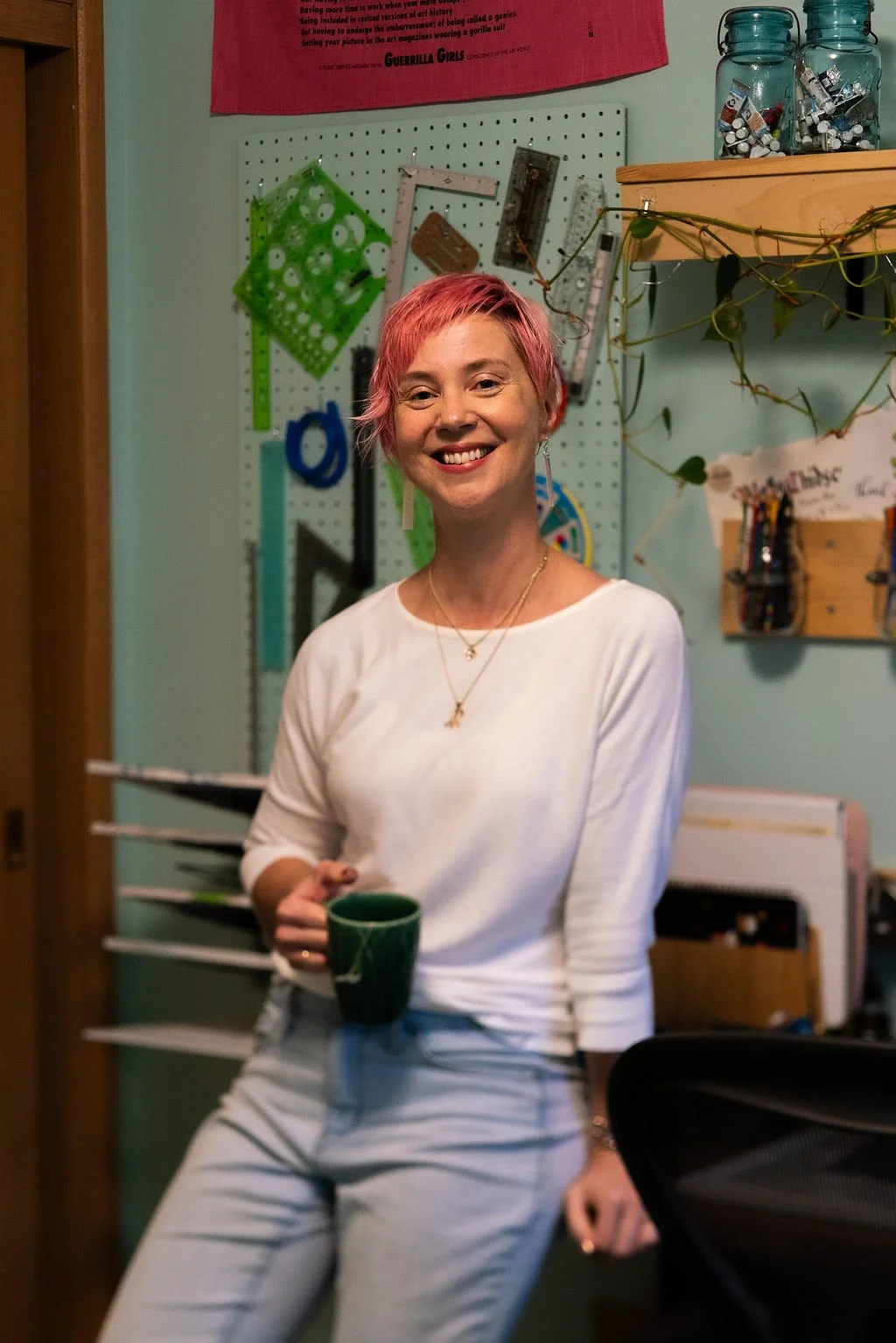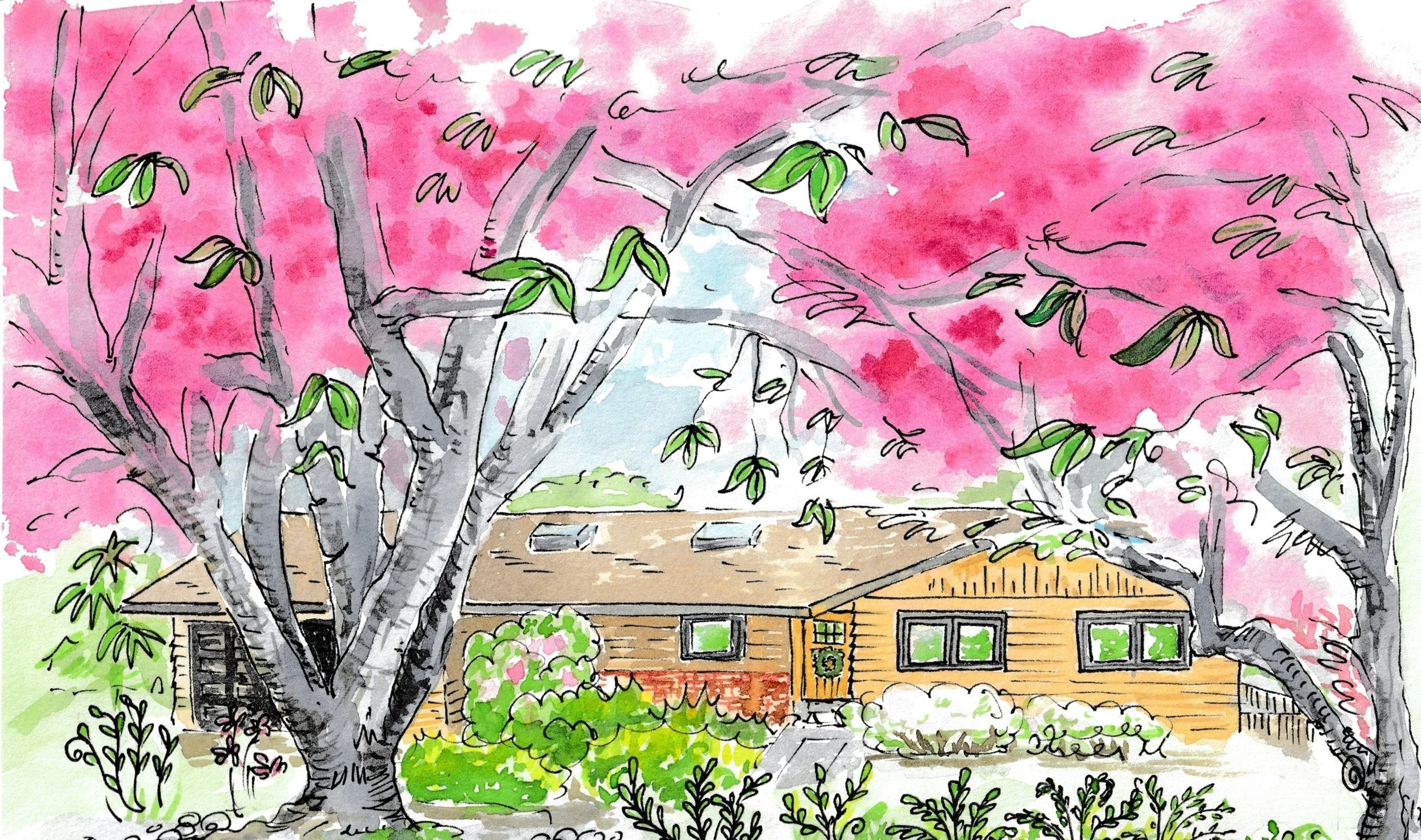Pink: The color everyone loves to hate
Me in my studio. Photo by STUDIO NUNCHI PDX.
I used to HATE the color pink.
Well, not always. When I was little, I loved it, along with all things sparkly, bright, and iridescent.
Then, in my teenage years, I got tough. It was the 90’s, and I dyed my hair burgundy, wore brown lipstick, and listened to The Cure. Pink was definitely out, and I tried to disassociate myself with all I thought it represented: vulnerability, love, romance, and heartbreak.
It wasn’t until many years later that I realized I’d fallen into the trap engrained in me by the dominant culture to associate pink with cultural assumptions of femininity, within a patriarchal context.
It turns out there is a reason I was socialized to dislike this color. For that, we need a brief history lesson.
History of pink
One day in color theory class, my very first term of art school, I got an assignment. The instructor walked around the classroom with a baseball hat holding strips of paper with a color written on each one. Of course, I drew the color pink. Here is a brief summary of what I learned.
I sketched this nootka rose on-site at the Fernhill Wetlands in Hillsboro, Oregon. Available as an art print in my shop.
Pink becomes a color
The word pink was first used in the English language to describe a family of flowers, collectively known as “pinks.”
It wasn’t until the 1700’s that the word was used to describe a color (Oxford English Dictionary, reference below). In nature, it’s the color of lovely things like flowers and sunsets.
Things get dark.
When it comes to human history, pink has a dark side. In the past century, pink has been used to connote patriarchy, xenophobia, homophobia, and the carceral system (see references #2, #3, and #4 below to learn more).
Learning this history helped me put this color into perspective, and to take a second look and appreciate its beauty.
Pink: reclaimed
Thanks to queer activists throughout the 1900’s, pink was reclaimed as a color fueling a movement for love and justice (references #4 and #5 below).
As a white, cisgender, straight woman, I acknowledge that to me, pink could be just a color. To the activists who put their lives on the line to fight for their rights to live and love freely, it represented so much more.
Going pink
I had always wanted pink hair, but my hair is naturally dark brown. I tried everything from highlighters to beet juice to naturally tint my hair pink. Finally, after I retired from my mainstream job and started working for myself, I went for it.
Now, I see pink as sort of a calling card. It signals my own strength and vulnerability, my desire to be myself. To make art that is bright and colorful, expressive and alive. To challenge the notion that watercolor, as an artistic medium, isn’t worthy of what I express with it.
Long after I dyed my hair pink, I incorporate it into my art, and my brand. If you are looking for a design partner to help you express your truest self, let’s talk. I would love to work with you.
Me in my studio. Photo by STUDIO NUNCHI PDX.
Free Watercolor Course
Discover and explore the beautiful shades of pink with my free online watercolor course, where you can unleash your creativity and learn to blend colors like a pro!
Create a watercolor card with my simple and fun techniques. I included a printable template so you can get right to the fun part... painting! This course teaches you how to set up your watercolor workspace, selecting colors and supplies, painting techniques, and video instruction. Stick around to the end for a surprise visit from my puppy, Milo.
I created this YES with pink watercolor and rubbing alcohol. What will you create with pink?
References
The surprisingly dark history of the color pink by Julie Irish, Fast Company, 2018.
Pink wasn’t always girly: a short history of a complex color by Anna Broadway, The Atlantic, 2013.
The pink triangle: from shame to pride, by By Andrew Ramer and CJM Associate Curator Anastasia James, Contemporary Jewish Museum website, 2017.
The Story of Pink: How Queer + Trans Liberation and Feminism have always been Intertwined, by Alexander Petrovnia, Published in An Injustice!, republished on Medium.com, 2021.
Never miss a post
Sign up to be notified whenever I publish a new post on my blog, Behind the Scenes.






